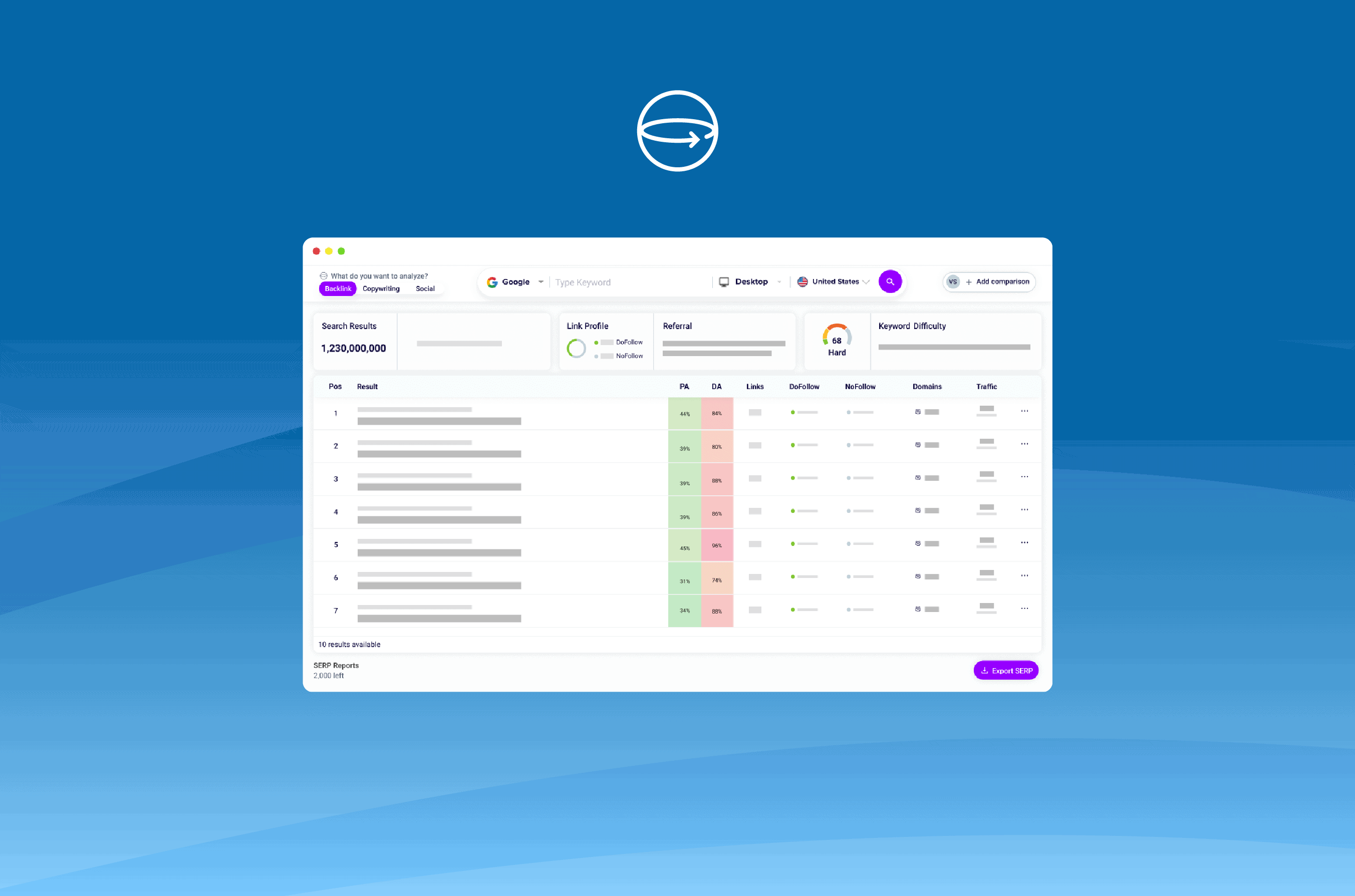Guide to SERP Analysis with the SERP Checker 360°
With this guide, you’ll learn how to use SEO Tester Online’s SERP Checker 360° to make a SERP Analysis, better study your competitors, and improve your SEO ranking. In this way, you can attract more traffic to your website.
What is the SERP?
The Search Engine Results Page (SERP) is the page that appears on search engines such as Google, Bing, Yahoo, Amazon when you search for a keyword.
To learn more about it, its elements, and the different types of results, you can have a look at our dedicated blog post.
SERP Analysis: Why is it important to do it?
Analyzing SERP is an activity that, when combined with an effective Keyword Research activity, allows you to learn more about your competitors and your market.
Keyword Research is excellent for getting ideas about the content that best positions you for a keyword and to understand what is interesting for the users.
It helps you write articles or create product cards because you’ll better understand what people are looking for on search engines and what they find on SERP.
You can study the strengths and weaknesses of the ranked pages and their snippets, and what is the level of the competition for the keyword you are analyzing.
SERP Analysis: Metrics and Basic Concepts
Now that you know why you should do a SERP analysis let’s see what metrics and concepts you’ll need to study your competitors.
Sign in to SEO Tester Online and go to SERP Checker 360°. Then, enter the query you want to position yourself.
You can also select the aspect you want to analyze. If you’re undecided just click enter, you’ll be able to switch from one aspect to another with a click.
The aspects you can analyze are:
- Backlinks
- Copywriting
- Social
Let’s dive into every aspect and find out why it is critical in SEO analysis.
Links
Link building increases the quantity and quality of incoming links to a website. It’s critical to understand how your competitors do it for the keywords with which you want to position.
In your SERP analysis, you need to focus on backlinks. These are the links from other websites that point to a specific domain.
The more quality backlinks you have, the greater is the chance for your site to be seen as authoritative by Google and to position itself among the top results of the SERP.
That’s why, when you search, among the most ranked results, you find Amazon or Wikipedia, two of the sites with the most significant inbound link flow.

Page Authority e Domain Authority
The Page Authority (PA) is a score that influences the ranking of a given page. It has a value between 1 and 100.
Instead, the Domain Authority (DA) is a score that predicts the extent to which a domain will rank on the search results pages, with values between 1 and 100.
The DA and PA help you identify the value of a site in terms of “quality” and the value of incoming links. Usually, higher volumes of DA and PA make a site more authoritative for Google, and this influences the ranking within the SERP.
It’s essential to monitor your competitors’ Domain Authority and Page Authority to you improve your site’s DA and PA.
Estimated monthly visits
It is the estimated traffic that a web page receives from Google for a keyword, calculated on search volume and average CTR.
This metric is especially useful in the second phase of SERP Analysis.
Social

These are the number of shares, comments, and reactions on Facebook for a given URL.
Although they do not affect the ranking, they provide the search engine with indirect signals (the so-called “social signals”), which indicate that users appreciate the content of that page. If you think about it, engagement and traffic for that URL on social networks are a popularity index, let alone a traffic source.
If you want to learn more about it, go to our article on SEO and social networks!
Copywriting

Content is the single most crucial aspect of SEO. We dedicated an entire section of our blog to it!
When we talk about content, we talk about images and, most important, copywriting. You need to write well-designed content (we wrote a manual about it!) and to apply SEO Copywriting strategies by keeping an eye on the several elements that make up SEO-oriented content (you can learn more about them on our guide to SEO Editor.
On the left of the SERP Checker 360°, you can find on the left the best ranking results. On the right, you’ll find the same data you could find on Copy Metrics. To learn how to read it, go to the guide to Copy Metrics.
How to Conduct an Effective SERP Analysis
Introduction
To get as much SERP information as you can, you need to follow three steps:
- Ask yourself the right questions;
- Do keyword research;
- Analyze your competitors.
If you want to make the most of this guide, we recommend that you use our SERP 360.
Ask yourself the right questions
Before you start analyzing SERP and immerse yourself in a world of metrics and numbers, stop for a moment.
Now, ask yourself four simple questions to get a more precise framework about the current state of your business.
- What is your market niche?
- Who are your competitors?
- How does your business differ from those of your competitors?
- For what content are your potential users searching?
To understand the market niche means to study your competitors and understand what makes you different from them. It can help you create the initial brief.
This document will not only help you analyze SERP but will also allow you to write content that meets the needs of your potential users.
Don’t worry if you can’t answer all these questions. SERP Analysis will also help you to be more aware of who your competitors are and what your business can offer to your market niche.
Do a Keyword Research
Start your search by entering a keyword that describes your business or identifies one of the topics you would like to cover on your site with the Keyword Explorer Tool. If you don’t know how to use it, jump on the dedicated guide.
Analyze your competitors
The time has come for you to analyze the SERP to understand your competitors better and, therefore, for which keywords they rank and how they set their snippets.
Let’s start with the steps that will help you to understand better how to act.
Example 1 – Web Agency
Let’s pretend, for example, that you run a web agency that targets early-stage startups. One of the topics you can cover is lean management.

From this screen, you can get a lot of information.
First of all, you can notice that the KD is medium-high: 65 is a value with which it is not very easy to position, but not impossible.
From the top section, you can see the presence of “Special Results,” such as “people also ask, featured snippets, and a knowledge graph.
The latter is a card linked to a specific query. It means that the intent for that search will be informational.
We’ve already talked about the different types of inputs in the keyword search guide (link). What you need to know is that users who use the “lean management” query look for general information about it and rarely have buying intentions.
That’s why, if you created content on the topic, you should aim at informing your user instead of selling them a product.
By analyzing SERP even better, you can see that the DA, except for Wikipedia and Kanbanize, and lean.org, is medium-low.
It means that the difficulty in positioning yourself for this keyword will be less than, for example, the keyword “startup.” The latter ranks among the top 10 results with high DA and PA values.

Going back to Wikipedia, you can see that the value of the DA and PA are related to the number of incoming links.
What information can you draw from this data?
The higher the quality of links is, the more a visitor from Google will see your website as authoritative. It means you need to apply a Link Building strategy and write complete and useful content.
Switching to copywriting, you will have an overview of how the best-positioned content looks like. By looking at the left of the screen, you’ll be able to see the language, the number of translations, and the word count of each ranked content.
Can you do better? Maybe with longer, more translated articles?

On the right, you have an in-depth analysis of each article. It is the same analysis you’ll find using the Copy Metrics. So, if you want to know more, go check its guide.

Finally, we switch to social. All our competitors have medium-to-low popularity on Facebook. Maybe we cannot match Wikipedia, but with a well-designed social media strategy, we can outperform the remaining competition.

Example 2 – Ecommerce
Let’s pretend now you have e-commerce that sells drills. If you search for the “drill” query on Keyword Explorer and filter results with a keyword difficulty of 65, you can find a valuable opportunity in the keyword “radial drill.”

In this SERP, you can observe the presence of ads, images, and videos.
It means that this is a transactional keyword and people searching it are ready to buy, so good news for your e-commerce. It also means that, if you want to position yourself for that keyword, it might also make sense to focus on optimizing videos and images in your e-commerce. Also, you should consider using a PPC strategy as well.
Example 3 – Physical Store
Whether you have a physical store, a restaurant, a clothing store, or a shop that sells dog food, this is an example for you.
Let’s say, for example, that you are a hairdresser. Therefore, you want to position yourself for the query “hairdressers Milan.”

Once you have the keyword, you can also observe that “Local Pack” category appears among “special” results.
It means that to be among the first results on Google’s first page, you should optimize your store’s Local SEO.
We also recommend taking hints from your competitors’ snippets and rich snippets within the SERP, trying to figure out which elements you need to add to optimize your results.
Finally, click on the three dots to the left of the single result within the SERP and choose between “Find the keywords” and “Analyze the page.”
There, you can learn even more about your competitors. In this way, you’ll be able to figure out for which keywords they rank and what their site’s SEO score is.
And don’t forget to export all your work to CSV!






